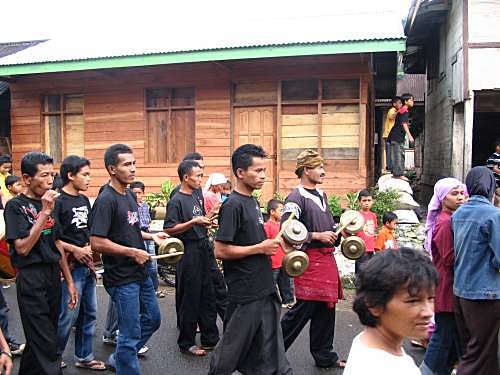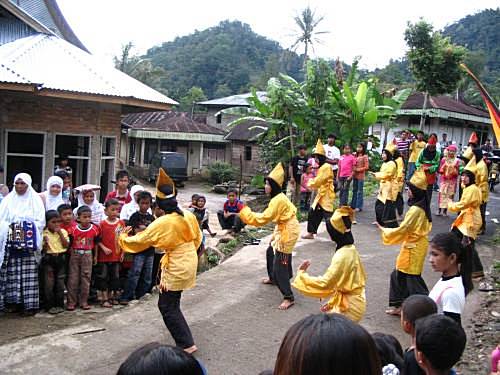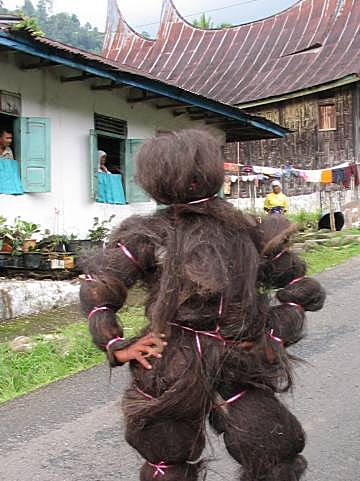Paul Mason
A Minangkabau man plays the role of a forest spirit (cimuntu)Paul Mason |
The small hillside village of Andaleh Baruah Bukik lies deep in the highlands of West Sumatra, the area that forms the cultural epicentre of the Minangkabau people. Each year, the villagers hold a Hari Raya celebration to mark the end of the fasting month. The festivities begin with the activities of the cimuntu – ghosts from West Sumatra’s mystical past that still live in the Minang imagination. Just before the Hari Raya festivities begin, members of the community sneak up into the mountains and disguise themselves in coconut hair or coconut leaves, taking on the guise of the cimuntu. They walk down the mountain and through the village collecting money and summoning people to the front of the town mosque to join in the celebrations. No one knows their identities. They play the part of naughty ghosts that scare children, while simultaneously coordinating and controlling the events that make up this special version of Hari Raya.
The Hari Raya festivities include various performances and a popular game where young men from the village form two teams, each trying to climb tall wooden poles, made from trunks of the Pinang tree smeared in grease. The climbing of the Pinang adds a comedic element to the festivities. Although this is ostensibly a competition, onlookers are less interested in the race than in the entertaining sight of men slipping and falling down the pole. The cimuntu have a hard time controlling the crowd as it presses to get nearer the poles.
These contemporary festivities are a mixture of Minangkabau tradition, Islamic religion and various modern influences, with a history that dates back to at least the 1930s. Nowadays, the celebrations run for many days and involve various artists, who bring the community together through music, dance and performance. These performances offer a window into the changing cultural world of the Minangkabau people, revealing re-creations of tradition juxtaposed with interpretations of the modern.
Reinventing performance traditions
The mainstay of any Minangkabau performance is a set of five or six hand-held kettle drums (talempong paciek) played by three or four musicians. As with much Indonesian music, the patterns played on the kettle drums interlock together. Another popular form of entertainment is the double-sided barrel drums (gendang tambuah) that hang from the shoulder and are played loudly for the enjoyment of all. The music is used to entertain, and also to accompany a number of Minangkabau performances (silek, debus, tari piriang).
 |
Group Sari Bunuan Macan Andaleh play kettle-drums in a processionPaul Mason |
Silek is the traditional martial art of West Sumatra. It is performed in pairs to demonstrate open hand combat and weapons training, accompanied by the kettle drums and the loud, rough hum of a bamboo reed instrument called a sarunai. The sarunai is played continuously, emphasising the tension between opponents and mimicking the sustained concentration among them. For the Minangkabau, the interlocking patterns of the kettle drums are a strong metaphor for the interlocking movements of the silek performers. The beauty of the art relies on the synchronous performance of essential footsteps by the two performers, which the kettle drums symbolically replicate.
Hip-hop dances and improvised rap punctuate the performances of silek, debus and plate dancing
All other West Sumatran performance arts are said to derive from this martial arts/dance form. For example, in the plate dance (tari piriang), the practitioner swings plates without dropping them or breaking them. In doing so, he or she draws on the same form of ‘energy’ cultivated in the martial art. The plate dance has become the iconic dance of West Sumatra. Debus, another performance form related to the martial art of silek, has a heightened mystical content. Practitioners cut themselves with knives, jump on broken glass with bare feet and burn themselves with fire, all without drawing blood or inflicting pain.
In more recent years, these traditional art forms have .been complemented by new performances. Hip-hop dances and improvised rap now punctuate the performances of silek, debus and plate dancing. The community of Andaleh may live deep in the mountains, but this has not stopped the spread of modernity. While they strongly stress tradition, the musicians of Andaleh have incorporated the African djembe into their music; the performers sometimes wear jeans and T-shirts, where once they would have worn traditional attire; and the dancers even occasionally perform to American pop music. Despite strong resistance from some traditionalist groups, silek is also changing, as it is influenced by the standard national form of the art.
Symptoms of broader change
The changing performances of the Hari Raya celebrations in Andaleh are indicative of deeper cultural shifts. Minangkabau society boasts a matrilineal heritage, but has now almost completely adopted the nuclear family structure. Women once held authority over the traditional Minangkabau houses, with their typical double-peaked roofs and thatched walls. These have been abandoned for concrete houses where men play a more important role.
Women can now play an active role in festivities and become performers of tradition
But these same changes have not only brought new privileges to men. They have also allowed women to play an active role in festivities and become performers of tradition. Before the shift to the nuclear family, young boys were not allowed to live at home. At an early age, they were required to leave home to be raised in a traditional commune called a surau, where they lived until marriage. Here they were taught tradition, religion and other life-skills. Their training also involved basic lessons in silek, after which they could develop skills in other performance arts and games.
 |
Girls performing a traditional Minangkabau dancePaul Mason |
Now, silek is no longer exclusively for boys, and all boys are no longer obliged to practice it. Many schools have become less secretive and training methods have altered. This has led to changes that have spilled over into other arts. For example, the plate dance, along with other popular Minangkabau dances, no longer uses the closed postures and solid stances that once marked its relationship to silek.
There is a Minangkabau proverb that states, ‘indak lakang dek paneh, indak lapuak dek hujan’, meaning that some Minangkabau traditions are unchangeable and are ‘not worn out by the sunshine, nor eroded by the rain’. But changes in Minangkabau arts reflect broader changes in West Sumatran society. Another Minangkabau proverb is arguably more appropriate, ‘alam takembang jadi guru’ – the ‘blooming of the world is a teacher’. The social ecologies of the Minangkabau people are expanding as they become more exposed to outside influences. Correspondingly, their arts are evolving as they embrace change and adapt to new cultural environments.
At the threshold of cultural change, the contemporary performances of the Hari Raya festivities in Andaleh represent a constant negotiation between regional heritage, national influences, and the pull of global trends. The culturally entrained bodies of the silek performers, the tari piriang dancers and the debus mystics are part of a lived present that is constantly recreating itself. In many ways, then, the performance arts of this community are representative of the wider cultural shifts felt throughout West Sumatra, as external influences and internal social change redefine what it is to be Minangkabau. ii
Paul Mason (paul.mason@scmp.mq.edu.au) is a PhD student at Macquarie University. He would like to thank Pak Indra Utama and Bu Ernida Kadir from the Dance Department at the Indonesian Performing Arts College (Padang Panjang), and Pak Fadil from the Television Studies Department, who assisted him with his fieldwork in Andaleh Baruah Bukik.
